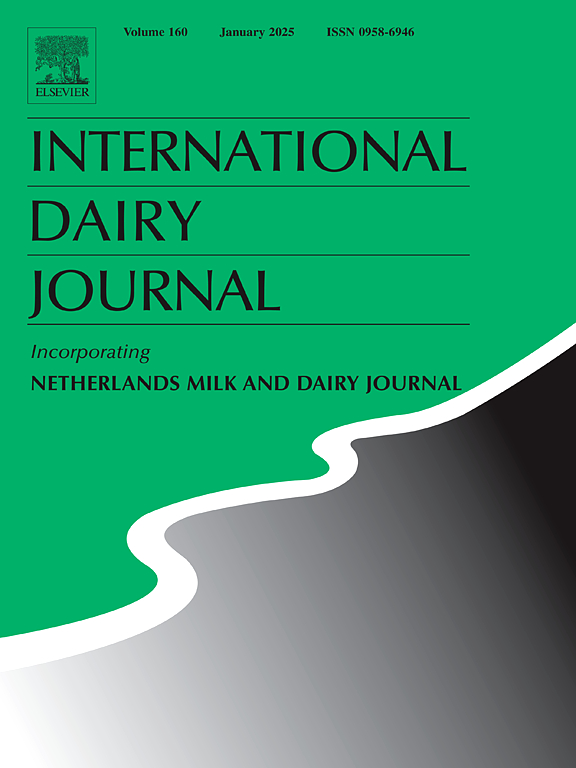Impact of sublethal treatments on dormant and non-dormant populations of Bacillus cereus spores during spray drying and on their recovery during whole milk powder storage
IF 3.4
3区 农林科学
Q2 FOOD SCIENCE & TECHNOLOGY
引用次数: 0
Abstract
This study evaluated the resistance induced by sublethal thermal stress to mimic heat processes employed during dried milk production chain on the survival of Bacillus cereus spores during spray drying. Three B. cereus strains (strains 436, B63 and 540) were exposed to four sublethal stresses before spray drying of whole milk. In treatments 1, 2 and 3, heat shocks were applied at two different temperatures (80 °C and 90 °C) and exposure time ranged between 10 and 30 min. Treatment 4 was a combination of heat shock at 72 °C/15 s, cold shock at 4 °C/12 h and another heat shock at 72 °C/15s. The counts of B. cereus spores were conducted with no heat shock and also applying heat shock (75 °C/20 min). The powdered milk obtained was stored at room temperature for 180 days and the counts of B. cereus were also determined employing no heat shock and heat shock (75 °C/20 min). The results indicated that sublethal treatments increased spray drying resistance of strains B63 and 540 and their survival during the storage period. The counts of B. cereus spores after 180 days of storage varied between <1.00 and 4.4 log10 spores/g of dry weight. These results demonstrate the importance of constant monitoring of the milk quality; once the thermal stresses occur during the dried milk production chain, it may increase the resistance of B. cereus spores, making it hard to effectively control this bacterium.
亚致死处理对喷雾干燥过程中蜡样芽孢杆菌休眠和非休眠种群及其在全脂奶粉储存过程中恢复的影响
本研究评估了亚致死热胁迫对蜡样芽孢杆菌孢子在喷雾干燥过程中存活的影响。对3株蜡样芽孢杆菌菌株(436、B63和540)在全脂牛奶喷雾干燥前进行了4次亚致死处理。在处理1、2和3中,热冲击在两种不同的温度(80°C和90°C)下施加,暴露时间在10到30分钟之间。处理4是72°C/15s热冲击、4°C/12 h冷冲击和另一个72°C/15s热冲击的组合。蜡样芽孢杆菌孢子计数在不热休克和热休克(75°C/20 min)条件下进行。将得到的奶粉在室温下保存180天,并在无热休克和热休克(75°C/20 min)下测定蜡样芽孢杆菌的计数。结果表明,亚致死处理提高了菌株B63和540的抗喷雾干燥能力和贮藏期存活率。贮藏180 d后蜡样芽孢杆菌孢子数在1.00 ~ 4.4 log10孢子/g干重之间变化。这些结果表明了持续监测牛奶质量的重要性;在干奶生产链中一旦出现热应力,可能会增加蜡样芽孢杆菌孢子的抵抗力,使这种细菌难以得到有效控制。
本文章由计算机程序翻译,如有差异,请以英文原文为准。
求助全文
约1分钟内获得全文
求助全文
来源期刊

International Dairy Journal
工程技术-食品科技
CiteScore
6.50
自引率
9.70%
发文量
200
审稿时长
49 days
期刊介绍:
The International Dairy Journal publishes significant advancements in dairy science and technology in the form of research articles and critical reviews that are of relevance to the broader international dairy community. Within this scope, research on the science and technology of milk and dairy products and the nutritional and health aspects of dairy foods are included; the journal pays particular attention to applied research and its interface with the dairy industry.
The journal''s coverage includes the following, where directly applicable to dairy science and technology:
• Chemistry and physico-chemical properties of milk constituents
• Microbiology, food safety, enzymology, biotechnology
• Processing and engineering
• Emulsion science, food structure, and texture
• Raw material quality and effect on relevant products
• Flavour and off-flavour development
• Technological functionality and applications of dairy ingredients
• Sensory and consumer sciences
• Nutrition and substantiation of human health implications of milk components or dairy products
International Dairy Journal does not publish papers related to milk production, animal health and other aspects of on-farm milk production unless there is a clear relationship to dairy technology, human health or final product quality.
 求助内容:
求助内容: 应助结果提醒方式:
应助结果提醒方式:


